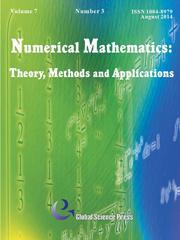No CrossRef data available.
Article contents
Discrete Maximum Principle and a Delaunay-Type Mesh Condition for Linear Finite Element Approximations of Two-Dimensional Anisotropic Diffusion Problems
Published online by Cambridge University Press: 28 May 2015
Abstract
A Delaunay-type mesh condition is developed for a linear finite element approximation of two-dimensional anisotropic diffusion problems to satisfy a discrete maximum principle. The condition is weaker than the existing anisotropic non-obtuse angle condition and reduces to the well known Delaunay condition for the special case with the identity diffusion matrix. Numerical results are presented to verify the theoretical findings.
Keywords
- Type
- Research Article
- Information
- Numerical Mathematics: Theory, Methods and Applications , Volume 4 , Issue 3 , August 2011 , pp. 319 - 334
- Copyright
- Copyright © Global Science Press Limited 2011




